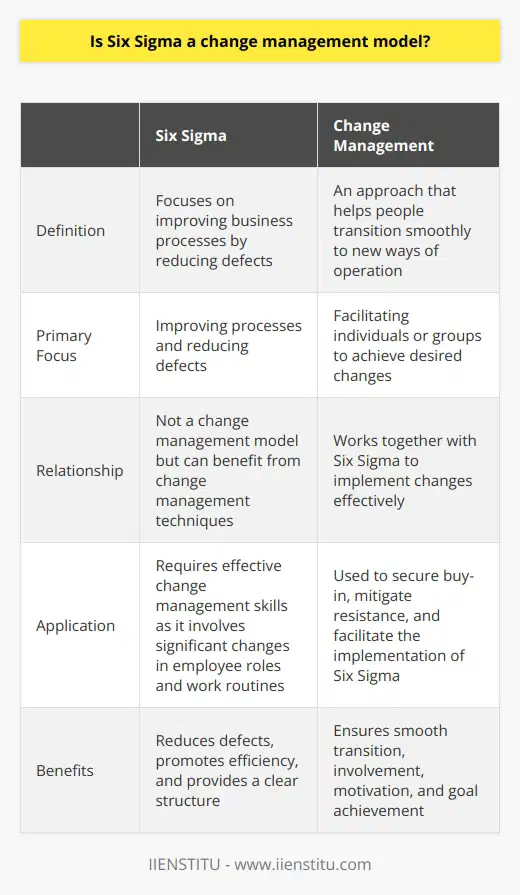
Introduction to Six Sigma and Change Management
Benefits of Implementing Six Sigma in Change Management
Challenges of Applying Six Sigma to Change Management
Strategies for Overcoming Challenges in Applying Six Sigma to Change Management
Conclusion: The Role of Six Sigma in Change Management
Six Sigma and change management are concepts often used interdependently in business and organizational processes. Six Sigma is a process-improvement methodology that identifies and eliminates errors and defects in an organization's processes. It is based on the principles of continuous improvement and focuses on the customer and their requirements.
On the other hand, change management is the process of planning, executing, and evaluating organizational changes. It involves assessing the impact of the change on the organization and implementing strategies to ensure that the transition is successful. The two concepts focus on improving an organization's processes and operations.
Benefits of Implementing Six Sigma in Change Management
There are many benefits to implementing Six Sigma in change management:
It can help organizations identify and eliminate process errors and defects. This can lead to greater efficiency and cost savings.
Six Sigma can help organizations identify and prioritize the essential changes that need to be made. This can make transitioning to a new system or process much more effective.
Implementing Six Sigma in change management can help organizations track progress and measure success, enabling them to make informed decisions that align with their objectives.
Challenges of Applying Six Sigma to Change Management
Although Six Sigma can be a powerful tool for managing change, some challenges come with its implementation. Finding the right person to lead a Six Sigma project can be challenging. This can be incredibly challenging in small organizations or those with limited resources.
Additionally, it can be difficult to introduce Six Sigma into an organization that is resistant to change. This can be a significant obstacle in the successful implementation of Six Sigma. Finally, it is essential to consider the cost of implementing Six Sigma and ensure that it aligns with the organization's budget.
Strategies for Overcoming Challenges in Applying Six Sigma to Change Management
To overcome the challenges of applying Six Sigma in change management, organizations should focus on training personnel in Six Sigma and ensuring adequate support for the project. Additionally, organizations should ensure that the right personnel is in place to lead the project and have the necessary skills and expertise. Furthermore, organizations should involve stakeholders in the process and ensure that they understand the objectives and goals of the project. Finally, organizations should ensure they have the necessary resources to implement Six Sigma and that the cost aligns with their budget.
Conclusion: The Role of Six Sigma in Change Management
In conclusion, Six Sigma can be a powerful tool for managing organizational change. It can help organizations identify and eliminate errors and defects in their processes, prioritize the essential changes that must be made, and track progress and measure success. However, some challenges come with implementing Six Sigma in change management. These can be overcome by training personnel, involving stakeholders in the process, and ensuring adequate resources and support for the project. Ultimately, Six Sigma can be a valuable tool for change management, helping organizations improve their processes and operations.
Six Sigma unlocks the potential of change management enabling businesses to reach their goals more efficiently.
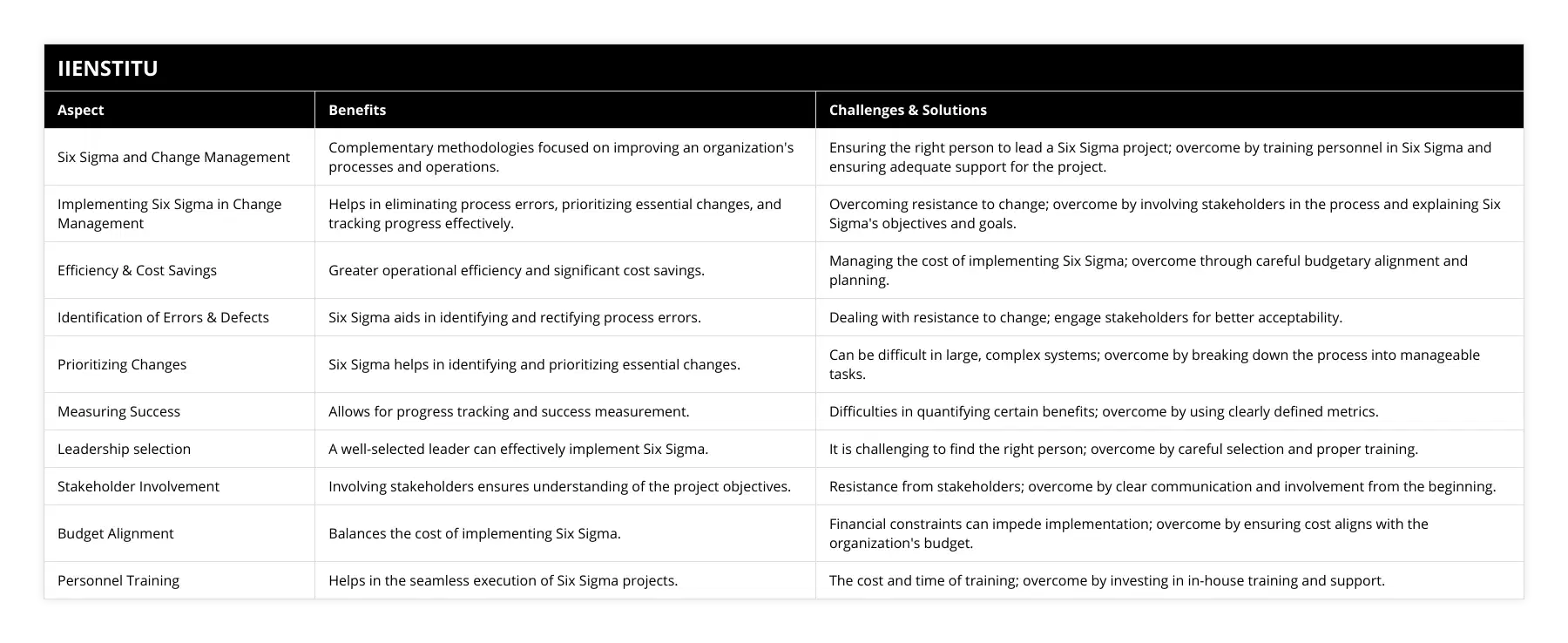
Frequently Asked Questions
What is Six Sigma and how does it relate to change management?
Six Sigma is a business management strategy developed by engineer Bill Smith while working at Motorola in the late 1980s. This strategy is designed to improve quality and reduce costs in manufacturing processes. The critical focus of Six Sigma is to identify, measure, analyze, improve, and control the performance of processes to achieve near-zero defects. In order to do this effectively, organizations must implement change management strategies that ensure a successful transition from traditional production and service delivery methods to those under the Six Sigma system.
Change management is an integral part of successful Six Sigma implementation. It helps bridge the gap between current services or products and how they should be delivered using Six Sigma principles. Change management requires effective communication between stakeholders, employees training for new roles and responsibilities, a clear understanding of the process changes that need to be implemented, proper implementation of those changes, and monitoring their effectiveness over an extended period.
Organizations implementing Six Sigma must also ensure that there are mechanisms for quantifying performance improvements based on data collection and analysis. Data-driven decisions are essential for process improvement as they provide evidence-based information on where resources should be allocated to achieve desired results within specific time frames. This involves collecting data related to cost savings, customer satisfaction levels, product quality, etc., measuring them against established goals, and taking corrective action if required.
In summary, Six Sigma provides organizations with efficient tools for reducing costs while improving quality standards; however, this can only be achieved if it is supported by effective change management strategies, including effective communication among stakeholders, proper training for employees on new roles and responsibilities within the organization as well as data-driven decision making through data collection and analysis which allows organizations to monitor performance improvements over an extended period.
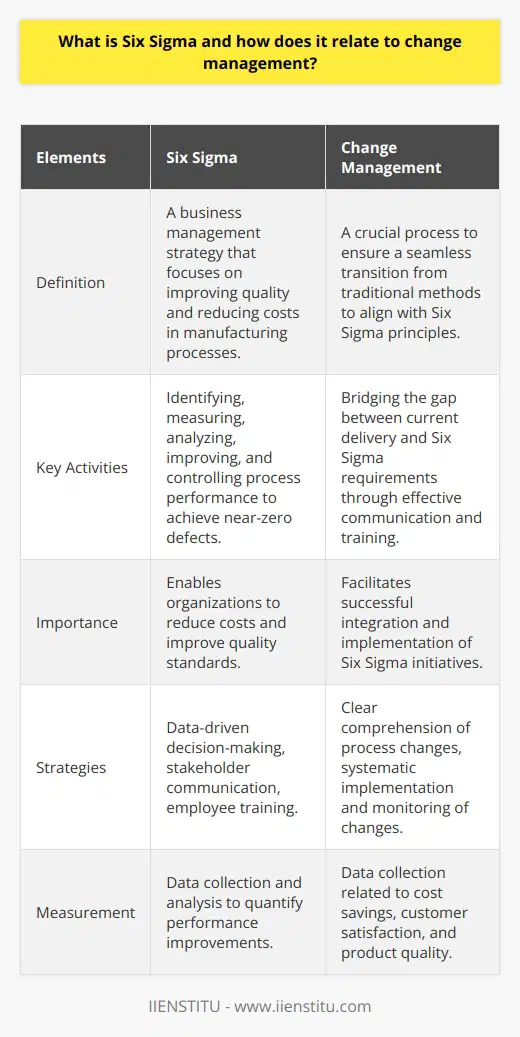
What are the benefits of implementing Six Sigma in change management?
Change management is an integral part of any organization. It is a process that involves planning, implementing, and managing the changes required to achieve a desired outcome. Six Sigma has become an increasingly popular tool used in change management in recent years. This article will discuss the benefits of implementing Six Sigma in change management.
The primary benefit of using Six Sigma in change management is the improved quality of results. By utilizing the Six Sigma approach, organizations can better identify, measure, analyze, and improve processes to reduce errors and improve performance. This results in improved quality of products and services, as well as a decrease in waste and costs. Additionally, Six Sigma allows organizations to identify the root causes of problems, allowing for more effective problem-solving and prevention of future issues.
Another benefit of using Six Sigma in change management is the increased process efficiency. Organizations can streamline processes and reduce the time required to complete tasks using the Six Sigma approach. This results in a more efficient operation and improved customer service. In addition, using Six Sigma can help organizations identify and address improvement areas more quickly, leading to faster implementation of changes.
Finally, Six Sigma can help organizations manage risk better. By utilizing the Six Sigma approach, organizations can identify potential risks and develop strategies to mitigate those risks. This can help organizations to avoid costly mistakes and ensure that changes are implemented in a controlled and effective manner.
In conclusion, Six Sigma can provide organizations with numerous benefits regarding change management. Improved results, increased efficiency, and better risk management can help organizations achieve their desired outcomes more effectively and efficiently.
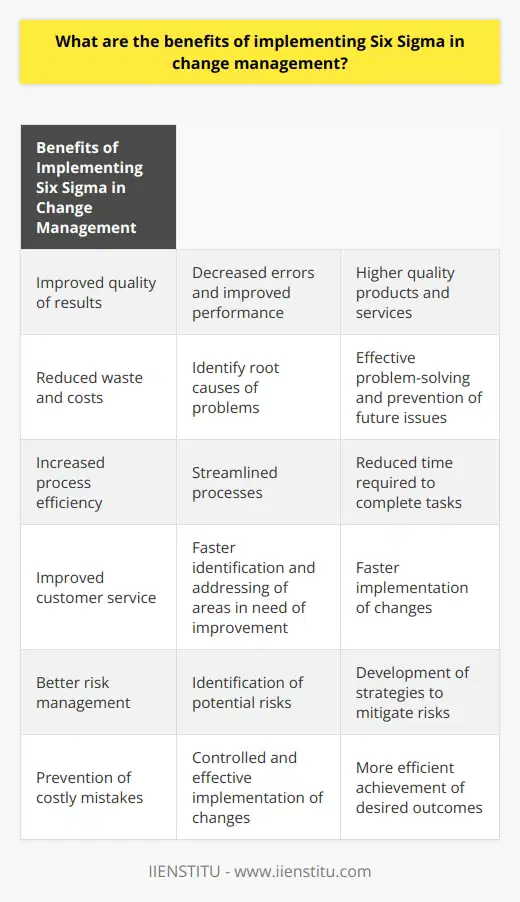
What challenges come with applying Six Sigma to change management?
Six Sigma is a set of tools and techniques to improve business efficiency and decision-making processes. In recent years, it has become increasingly popular as an approach to organizational change management. However, applying Six Sigma to change management also brings specific challenges that must be addressed for the change process to be successful.
One challenge associated with implementing Six Sigma in change management is that the approach is highly structured and prescriptive. This can be difficult for organizations accustomed to more informal change management methods. Additionally, the rigorous data analysis required by Six Sigma can be time-consuming and costly, making it difficult for organizations with limited resources to implement the method effectively.
Another challenge comes from resistance from employees who may view Six Sigma as too rigid or intimidating. This resistance can often lead to poor adoption rates, undermining any potential benefits of using this approach. Furthermore, without proper training and support for employees within an organization, there is a risk of misinterpreting or misunderstanding the methodology's underlying concepts and, therefore, not achieving desired outcomes from its implementation.
Finally, another challenge associated with applying Six Sigma in change management is that it requires continuous monitoring and feedback throughout the implementation process to ensure effectiveness. This means that organizations must have adequate resources available - both financial and human - in order to ensure successful implementation of the methodology over time.
The challenges associated with applying Six Sigma to change management are manageable; however, they require careful consideration before deciding whether or not this approach suits any given organization's needs. With proper planning and execution, however, organizations can overcome these challenges to reap the long-term benefits of successfully implementing this robust methodology within their organization's structure.
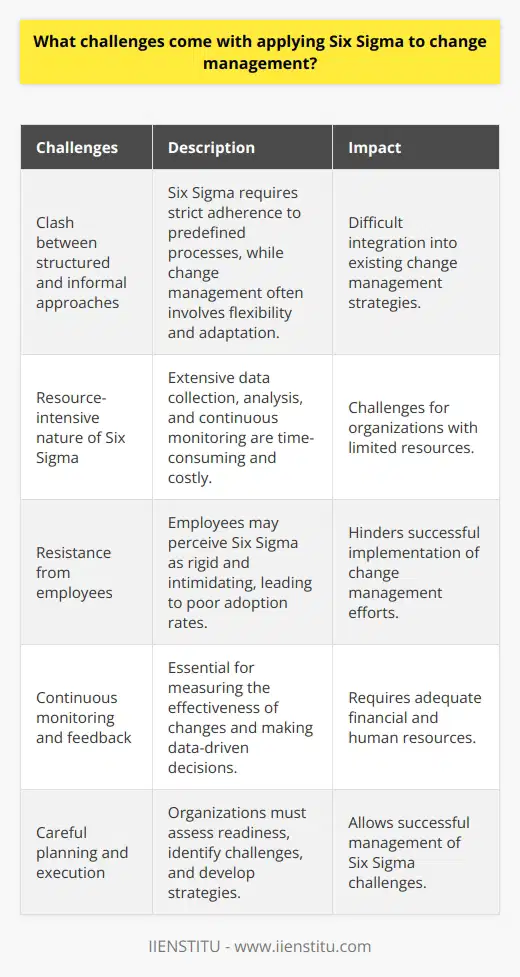
What is the Six Sigma approach to change management?
Six Sigma and Change Management
The Six Sigma approach to change management is a structured, data-driven methodology aimed at reducing variability and improving processes through measurable and quantifiable metrics. It encompasses a systemic strategy that guides organizational leaders in implementing effective changes by identifying and prioritizing areas for improvement, developing targeted solutions, and monitoring the impact of those solutions on performance indicators.
Principles of Six Sigma
The foundation of Six Sigma lies in five key principles: (1) defining the problem or opportunity for improvement, (2) measuring the current process performance and establishing baselines, (3) analyzing the potential root causes of the problem, (4) improving the process by implementing evidence-based solutions, and (5) controlling the new processes to ensure sustainability of the improvements. These principles align with traditional change management practices where clear goals, effective communication, and ongoing monitoring are paramount.
DMAIC Framework
Six Sigma employs a specific framework called DMAIC (Define, Measure, Analyze, Improve, Control) to guide the change management process. This iterative approach, starting with a clearly defined problem, ensures that changes are implemented in a systematic and efficient manner. The DMAIC framework emphasizes objective measures, rigorous analysis, and continuous improvement strategies, which are critical elements for successful change management.
Role of Change Agents
In the Six Sigma approach, change agents play a crucial role in driving and supporting the transformation efforts. These professionals, often referred to as Black Belts or Green Belts, are trained in Six Sigma methodologies and tools, and possess the skills and expertise necessary to facilitate change in an organization. Their role includes mobilizing stakeholders, coaching team members, and leading the implementation of data-driven solutions.
Benefits of Six Sigma
The Six Sigma approach offers several advantages in managing change. Firstly, it ensures that any changes are grounded in data and evidence, leading to better decision-making and improved outcomes. Also, the strong focus on process improvement helps to create a culture of continuous learning and improvement, which is critical for sustained success in a rapidly changing business landscape. Furthermore, Six Sigma's structured approach reduces resistance to change by engaging stakeholders and providing clear communication on the objectives and benefits of the transformation.
Overall, the Six Sigma approach to change management presents an effective, data-driven strategy for organizations to achieve lasting improvements in performance, efficiency, and customer satisfaction. By leveraging the DMAIC framework, applying critical principles, and utilizing skilled change agents, Six Sigma facilitates the successful implementation of change and fosters a culture of continuous improvement.
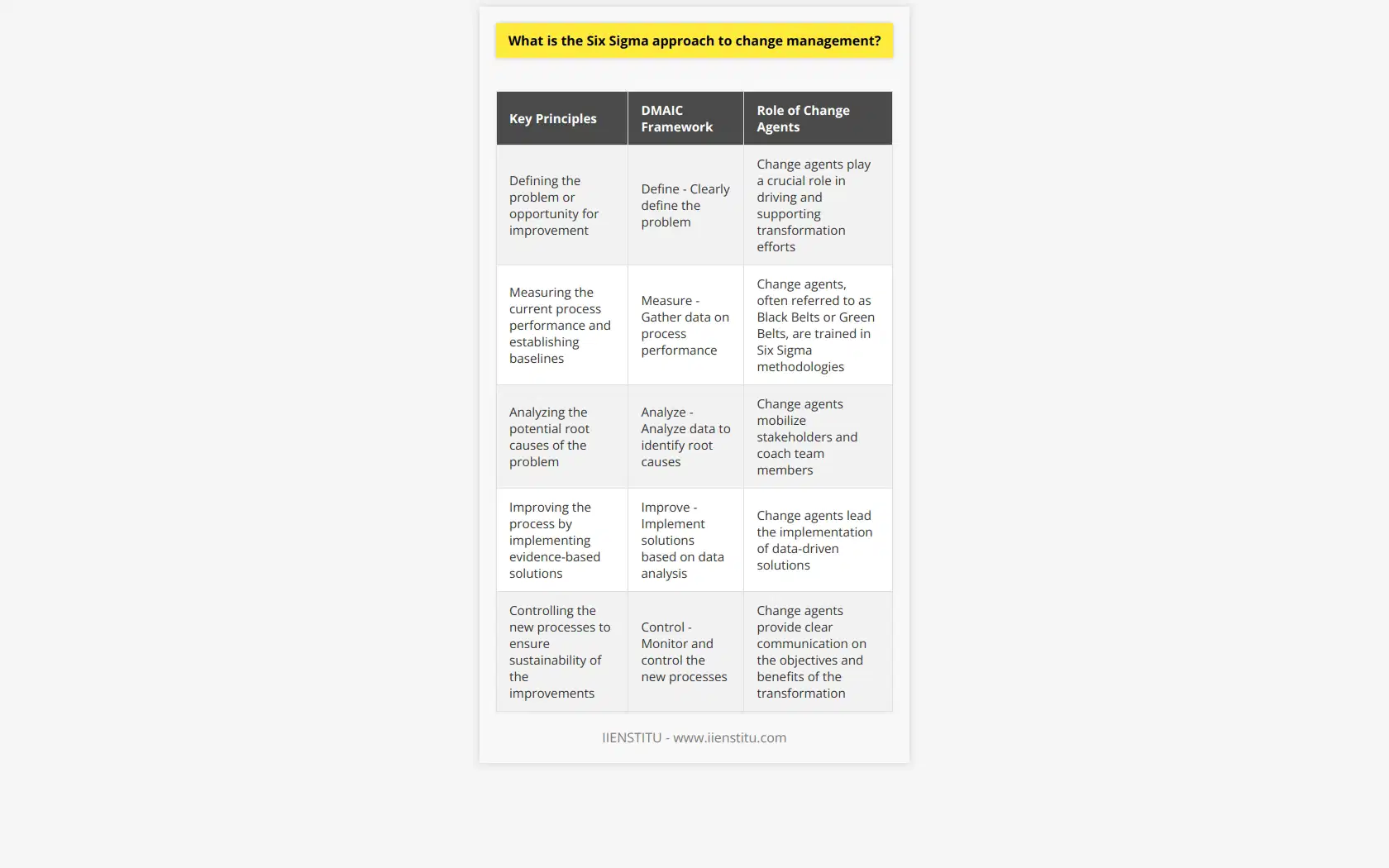
What value could Six Sigma potentially give to an organization?
Value of Six Sigma Implementation
Six Sigma can potentially offer immense value to an organization by streamlining its business processes and enhancing operational efficiency. The methodology focuses on identifying the root causes of problems and implementing evidence-based solutions, leading to significant improvements in performance.
Cost Reduction
A primary advantage of Six Sigma is its ability to minimize production costs. By reducing defects and waste, organizations can achieve substantial savings in material and labor expenses. This improved efficiency translates directly into increased profits and a higher return on investment.
Improve Customer Satisfaction
Six Sigma also plays a crucial role in enhancing customer satisfaction. By ensuring that products and services consistently meet or exceed customer requirements, organizations can build a loyal customer base and maintain a competitive edge in the market. Furthermore, satisfied customers are more likely to recommend a company’s products and services to others, thereby increasing profitability.
Motivate Workforce
The implementation of Six Sigma fosters a culture of continuous improvement, motivating employees to actively seek ways to enhance their work processes. This sense of ownership and commitment to quality drives employee engagement, leading to higher levels of job satisfaction and staff retention.
Data-driven Decision Making
Six Sigma equips organizations with the tools needed to make informed, data-driven decisions. This objective approach enables companies to accurately identify opportunities for improvement and allocate resources effectively, optimizing overall business strategy.
Enhance Innovation
Lastly, Six Sigma promotes a learning mindset within organizations, promoting innovation and encouraging employees to think creatively in problem-solving. By constantly challenging existing procedures and developing new ways of working, organizations can remain agile and adaptable in an ever-changing business landscape.
In conclusion, by adopting the Six Sigma methodology, organizations can significantly optimize their operations, resulting in cost savings, increased customer satisfaction, a motivated workforce, data-driven decision making, and enhanced innovation. These benefits ultimately contribute to the organization's ongoing success and growth.
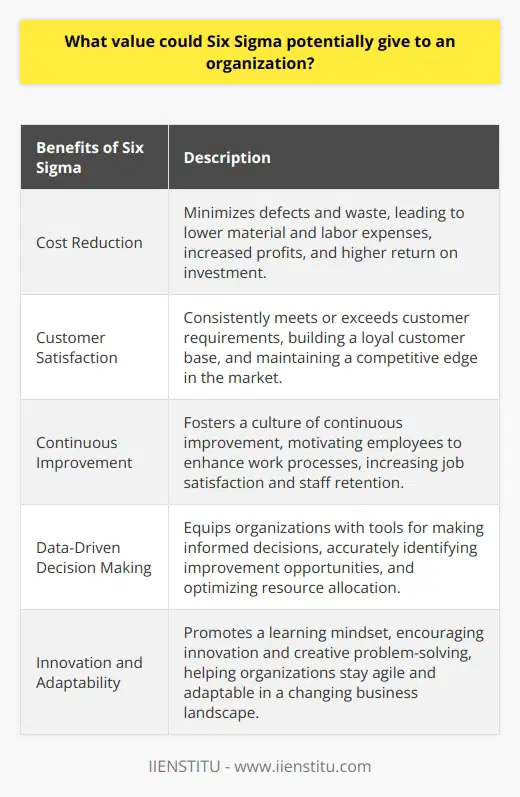
What is Six Sigma from a managerial perspective?
Understanding Six Sigma
From a managerial perspective, Six Sigma is a data-driven methodology for identifying and eliminating process defects, reducing variability, and ensuring quality outcomes in various organizational functions. The approach originated in the manufacturing industry but has gained widespread acceptance across various business sectors, as it offers a systematic framework for driving continuous improvement and achieving operational excellence.
Core Principles
There are five core principles underpinning the Six Sigma method, which managers need to grasp to successfully implement the approach. Firstly, customer focus is of paramount importance, as it emphasizes understanding and meeting clients' requirements and enhancing their satisfaction. Secondly, process orientation emphasizes evaluating and optimizing end-to-end workflows to deliver value-added results. Thirdly, data-driven decision-making removes guesswork and minimizes biases by using concrete evidence and reliable metrics to guide actions. Fourthly, proactive management empowers managers to anticipate potential issues and intervene before they escalate. Lastly, collaboration is key, as it fosters information sharing and cross-functional team engagement to drive collective performance.
DMAIC Framework
The central tool in Six Sigma implementation is the DMAIC (Define, Measure, Analyze, Improve, Control) framework. Managers utilize this structured problem-solving process to address performance gaps and enhance efficiency. The Define phase involves scoping the problem, outlining project goals, and clarifying customer requirements. During Measure, managers collect relevant data through various sources and establish baseline metrics for the process being improved. In the Analyze phase, managers scrutinize the collected data to identify root causes of defects and variability. The Improve phase involves designing and trialing solutions to address identified issues and testing their impact on process performance. Lastly, the Control phase ensures the sustained implementation of improvements through well-defined monitoring and control plans.
Importance of Certification
Finally, from a managerial perspective, Six Sigma certification is an essential aspect of successfully adopting the methodology. The certification process provides managers and staff with the necessary training, tools, and techniques to effectively apply the Six Sigma approach. The certification consists of various belt levels, which indicate the individual's mastery of the method. Employees with Green Belt or Black Belt certifications possess a deep understanding of the principles and can lead Six Sigma projects, while Yellow Belt and White Belt certified professionals contribute to project success in supporting roles.
In conclusion, Six Sigma offers a comprehensive and evidence-based strategy for managers to enhance process performance, reduce defects, and ensure customer satisfaction. By mastering the underlying principles, employing the DMAIC framework, and pursuing certification, managers can successfully leverage Six Sigma for organizational growth and excellence.
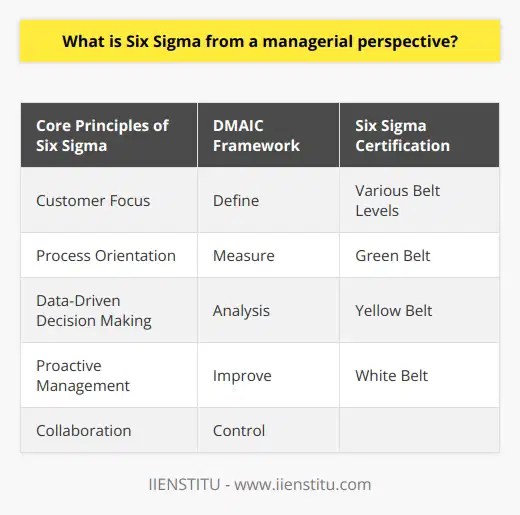
What does change management attempt to solve?
Understanding the Purpose of Change Management
Change management primarily aims to address the challenges and difficulties that emerge during the implementation of organizational changes. These changes, whether strategic, cultural, or technological, are introduced to enhance a company's operations, competitiveness, and overall performance.
Adapting to New Circumstances
Organizations need to continually adapt to stay relevant in dynamic market environments. Consequently, change management seeks to facilitate the smooth transition of employees, teams, and the organization as a whole from the current state to a desired future state.
Addressing Resistance
First and foremost, change management tackles resistance to change. People often resist changes due to fear of the unknown or perceived threats to their job security, role, or work processes. Change management interventions can help to mitigate these negative responses, improving employee acceptance and willingness to undergo change.
Clear Communication of Benefits
Another objective of change management is to convey the rationale and advantages of the change to employees. By articulating the benefits and explaining the need for change, employees become more inclined to embrace the new direction and contribute to the change efforts actively.
Providing Support and Resources
Change management also aims to provide employees with the necessary resources and support to adapt to the new environment. This can include offering training and development programs to equip employees with the skills required to excel in the changed workplace. Providing tools, equipment, or new technology can further facilitate employee adaptation.
Monitoring Progress and Evaluating Outcomes
Finally, change management focuses on evaluating the outcomes of change initiatives to identify areas for improvement and potential adjustments needed during implementation. This ensures that the change process is continually refined and that the desired goals of the change are ultimately achieved.
In conclusion, change management attempts to solve the challenges that arise when organizations implement changes by reducing resistance, enhancing acceptance, articulating benefits, providing support, and monitoring progress. By doing so, it helps ensure the successful realization of organizational objectives and creates a more agile and adaptable organization capable of thriving in an ever-evolving business landscape.
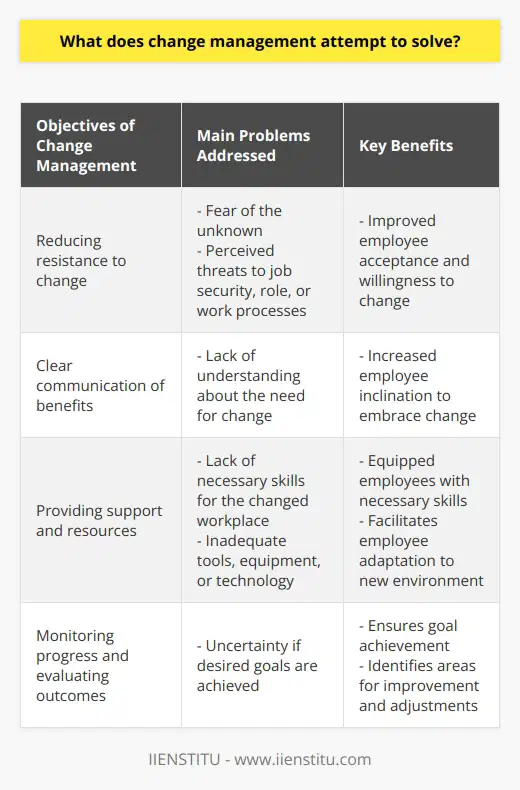
How can Six Sigma contribute to effective decision-making in change management?
Six Sigma's Role in Decision-Making
Six Sigma, a data-driven methodology for process improvement, has the potential to facilitate effective decision-making in change management. By emphasizing statistics and measurable data, Six Sigma helps organizations analyze their processes and make data-backed decisions for improvements. As a result, managers are better equipped to make strategic choices in change management initiatives.
Utilizing DMAIC
The DMAIC (Define, Measure, Analyze, Improve, Control) model is a cornerstone of Six Sigma's process improvement strategy. This systematic approach ensures thorough identification of issues, measurement of current processes, analysis of improvement opportunities, implementation of changes, and maintenance of new procedures.
Enhanced Decision-Making
Utilizing the DMAIC model ensures that change management decisions are made based on concrete data rather than gut feelings or assumptions. With the focus on evidence-based decision making, managers become more confident in their choices, and these informed decisions lead to more successful change initiatives.
Enabling Creative Solutions
Within the Improve phase of the DMAIC model, Six Sigma encourages the generation of creative solutions, fostering innovation within the organization. These innovative ideas benefit change management by allowing for the implementation of novel strategies that drive organizational growth and competitiveness.
Risk Mitigation
When implementing change, organizations often face uncertainty and risk. The systematic approach of Six Sigma allows for the measurement and analysis of potential risks, enabling managers to make informed decisions that minimize adverse impacts on the organization. This proactive risk mitigation contributes to the success of change management initiatives.
Continuous Improvement
Six Sigma's emphasis on continuous improvement complements the ever-evolving nature of change management. By monitoring and evaluating the implemented changes through the Control phase of DMAIC, organizations can ensure that their change management initiatives continue to meet the evolving needs of the business.
In conclusion, Six Sigma provides a structured path to facilitate effective decision-making in change management. By utilizing the DMAIC model, managers can make evidence-based decisions and ensure that implemented changes are monitored, controlled, and continuously improved. Additionally, Six Sigma promotes innovation and risk mitigation, both of which contribute to the success of change management initiatives.

How can organizations ensure successful implementation of Six Sigma within change management initiatives?
Organizations must follow effective strategies for successful integration of Six Sigma within change management initiatives. These strategies encompass a range of practices, from establishing a supportive culture to maintaining robust communication channels.
Create a Culture of Continuous Improvement
To effectively integrate Six Sigma, organizations must foster a culture of continuous improvement. This involves prioritizing employee development, encouraging innovation and promoting open communication at all levels. Emphasizing the value of Six Sigma methodologies as a key to achieving operational excellence, the workforce will be more inclined to embrace change.
Involve Leadership and Key Stakeholders
Leadership must be deeply involved in the Six Sigma integration process, actively supporting change and leading by example. By engaging key stakeholders and ensuring their commitment to the initiative, organizations can work towards a shared vision of success. Additionally, collaboration between Six Sigma Champions and Process Owners further strengthens the potential for successful outcomes.
Establish Clear Goals and Metrics
Setting clear goals and defining the metrics to measure progress is essential for assessing the impact of Six Sigma within a change management initiative. Organizations should identify the desired objectives, such as reduced cycle times, increased customer satisfaction or improved process efficiencies. Defining the metrics ensures that the team's efforts are directed towards specific targets, enabling more effective tracking and evaluation.
Develop Skilled Six Sigma Practitioners
Investing in proper training and certification of employees equips the organization's workforce with the necessary skills to apply Six Sigma tools and approaches. Offering ongoing educational opportunities and resources ensures a deep understanding of the methodology and drives successful integration within the change management process.
Maintain Robust Communication Channels
Effective communication is vital for transparent and consistent transmission of information related to the Six Sigma initiative. Organizations should establish channels that promote dialogue, disseminate relevant updates, and enable feedback to ensure alignment with organizational goals.
Monitor Progress and Encourage Feedback
Implementing Six Sigma requires continuous evaluation of progress and performance. Regularly reviewing the results of the applied methodologies allows organizations to identify areas for improvement and respond to challenges accordingly. Encouraging feedback from employees and stakeholders creates a holistic understanding of the effectiveness of the integration and fosters continuous improvement.
In conclusion, organizations can ensure successful implementation of Six Sigma within change management initiatives by creating a supportive culture, engaging leadership, defining the goals and metrics, developing skilled practitioners, maintaining open communication channels, and continuously monitoring progress.
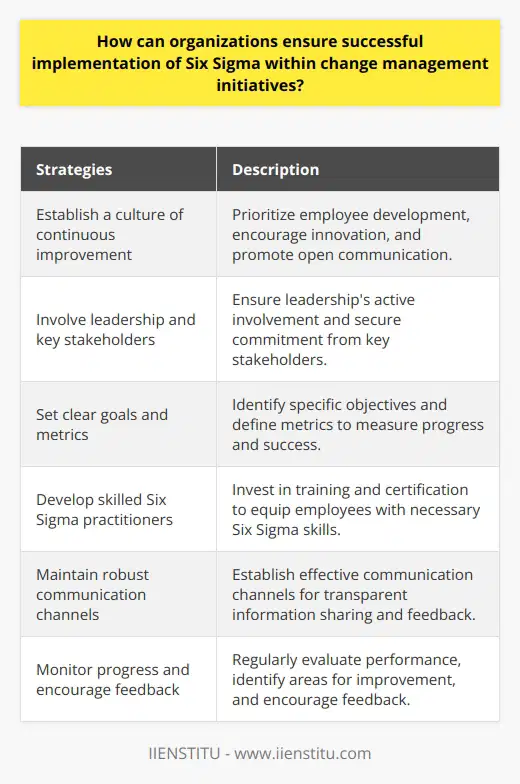
What is the role of Six Sigma and Lean principles in change management?
Role of Six Sigma in Change Management
Six Sigma plays a pivotal role in change management by providing a data-driven, systematic approach to identifying defects and inefficiencies in processes. This methodology comprises a set of techniques and tools for process improvement, aiming to enhance the quality of output and minimize variation. One of the critical components of Six Sigma is the DMAIC cycle, which stands for Define, Measure, Analyze, Improve, and Control. This cycle facilitates structured problem-solving and continuous improvement, enabling organizations to be more responsive to internal and external changes.
Application of Lean Principles
Concurrently, Lean principles facilitate change management by focusing on eliminating waste and improving efficiency within an organization's operations. The central tenets of Lean include identifying value from the customer's perspective, mapping the value stream, creating smooth workflows, establishing pull systems, and seeking continuous improvement. By adopting these principles, organizations can streamline their processes, enhance productivity, reduce costs, and ultimately deliver better value to customers.
Synergy between Six Sigma and Lean
By combining Six Sigma and Lean principles, organizations can optimize their change management efforts. This integrated approach, also known as Lean Six Sigma, allows companies to evaluate their processes from multiple perspectives – minimizing variation through Six Sigma and maximizing efficiency through Lean. Consequently, Lean Six Sigma aims at reducing errors, increasing speed, and enhancing customer satisfaction, thereby fostering a culture of continuous improvement and adaptability.
Benefits of Combining the Approaches
The synergy between Six Sigma and Lean in change management offers several advantages. First, it promotes a holistic understanding of process improvement, ensuring that organizations can address both statistical and practical aspects of their operations. Second, it encourages collaboration and engagement among team members, fostering a shared sense of responsibility and accountability for process improvement. Lastly, it equips organizations with a versatile toolkit for identifying and addressing change-related challenges, enabling them to remain agile and competitive amidst evolving market demands.
In conclusion, the integration of Six Sigma and Lean principles in change management empowers organizations to embrace change effectively and efficiently. By cultivating a robust, systematic, and customer-centric approach to process improvement, businesses can adapt to shifting market trends, optimize their operations, and drive sustainable growth.
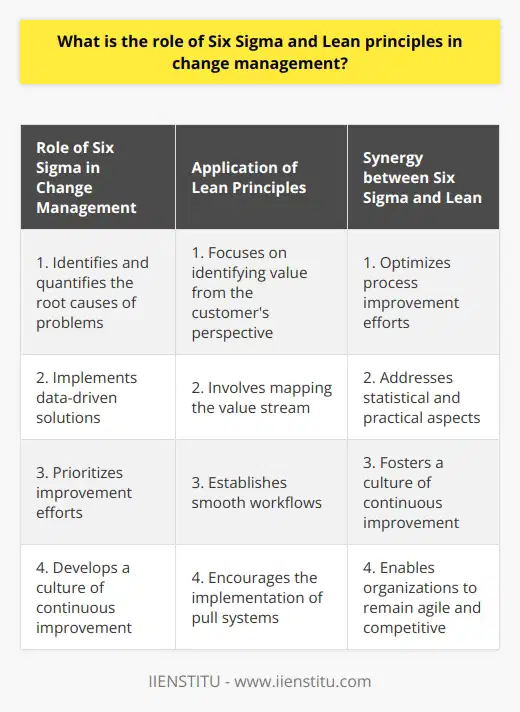
How do Six Sigma methodologies enhance the overall effectiveness of change management processes?
Enhancing Change Management Effectiveness
Six Sigma methodologies contribute significantly to the overall effectiveness of change management processes. Primarily, they offer a structured and data-driven approach, which facilitates the identification of the root causes of existing problems. By doing so, organizations can address these issues more efficiently and attain lasting improvements.
Influence on Organizational Culture
Furthermore, Six Sigma methodologies foster a culture of continuous improvement by promoting collaboration and communication among stakeholders. This collaborative environment enables employees to adopt and accept changes more easily, considering they are part of the decision-making process. Consequently, the heightened involvement of employees enhances ownership, accountability, and commitment to the change initiatives.
Supporting Decision Making
Additionally, the utilization of Six Sigma tools, such as Define, Measure, Analyze, Improve, and Control (DMAIC), enables organizations to make better-informed decisions. This systematic approach not only provides a clear roadmap for managing change effectively but also ensures that decisions are anchored on validated data. In turn, this approach minimizes resistance, as stakeholders can appreciate the rationale behind the proposed changes.
Minimizing Risk and Uncertainty
Moreover, Six Sigma methodologies also reduce the risk and uncertainty associated with change management initiatives. By relying on data-driven solutions, organizations can measure how effectively they are implementing the changes and make necessary adjustments to achieve their targets. This proactive risk management strategy ensures that organizations can overcome potential roadblocks while optimizing the success of the change efforts.
Reducing Variation and Enhancing Consistency
Lastly, Six Sigma methodologies can help organizations achieve consistency in their change management processes by reducing variations in performance. This consistency proves crucial, especially when standardizing procedures and expectations are needed to ensure seamless coordination and execution of change initiatives. Ultimately, the incorporation of Six Sigma principles leads to efficient, reliable, and predictable outcomes, which bolsters the overall effectiveness of change management processes.
In summary, Six Sigma methodologies offer valuable tools and approaches for enhancing the effectiveness of change management processes. By employing data-driven, structured techniques and fostering a collaborative culture, organizations can minimize risks, increase consistency, and achieve better results. Embracing Six Sigma principles brings substantial benefits to organizations, enabling them to overcome the challenges presented by today’s rapidly evolving business landscape.

In what ways can Six Sigma techniques be applied to various aspects of change management to reduce risks and ensure success?
Change Management Integration
Integrating Six Sigma techniques into change management can reduce risks and ensure successful outcomes in multiple ways. Primarily, this process-driven approach allows organizations to systematically identify and address potential shortcomings while establishing streamlined, efficient solutions.
Risk Assessment and Prioritization
One key aspect of employing Six Sigma in change management is the identification and prioritization of risks. By utilizing the DMAIC (Define, Measure, Analyze, Improve, Control) process, organizations can pinpoint potential failure points and resolve them proactively, thereby minimizing adverse impacts or unforeseen consequences.
Structured Communication and Feedback
Communication is vital in change management, and Six Sigma offers structured feedback mechanisms that ensure relevant stakeholder input. Establishing clear communication channels and feedback loops enables organizations to adapt and respond effectively to unexpected challenges or stakeholder concerns, ultimately bolstering the success of the initiative.
Data-driven Decision Making
Another benefit of Six Sigma in change management is its emphasis on data-driven decision-making. This quantitative approach helps decision-makers to effectively assess cause and effect relationships, prioritize key factors, and develop fact-based strategies to mitigate risks and accelerate change adoption.
Employee Support and Training
Incorporating Six Sigma methods to support and train employees can also prove instrumental in successful change management. By offering targeted training programs and fostering a culture of continuous improvement, organizations can ensure that employees possess the necessary skills and understanding to embrace and effectively navigate through significant transformations.
Monitoring and Continuous Improvement
Lastly, adopting Six Sigma methodologies facilitates a commitment to ongoing monitoring and continuous improvement. This vigilance in tracking progress, identifying setbacks, and devising corrective measures can cultivate a proactive stance towards change and foster resilience while ultimately reducing risks associated with change management.
In conclusion, applying Six Sigma techniques to various aspects of change management can notably decrease risks and contribute to the successful implementation of organizational transformations. The structured approach, clear communication, data-driven decision-making, employee support, and commitment to continuous improvement form the basis of Six Sigma's transformative potential.

What are the three phases of change process in Six Sigma?
Three Phases of Change Process in Six Sigma
Understanding the Change Process
The implementation of Six Sigma within an organization involves a comprehensive and systematic process of change to improve overall performance and customer satisfaction. This process can be divided into three distinct phases: initiation, execution, and institutionalization.
Initiation Phase
The initiation phase is the starting point of the Six Sigma change process, where the organization identifies its need for improvement and areas of opportunity. In this phase, organizational leaders define the problem or issue, analyze the root causes, and develop a clear vision for the desired future state. During this phase, leaders also assemble a dedicated team of professionals to drive the Six Sigma project, build support for the proposed changes, and facilitate open communication among stakeholders. Additionally, leaders establish measurable goals and metrics to track progress over time.
Execution Phase
Subsequently, the execution phase is when the organization begins implementing the planned changes in a disciplined manner to achieve the identified improvement goals. This phase focuses on executing the project plan, managing resources, and applying Six Sigma methodologies, such as DMAIC (Define, Measure, Analyze, Improve, and Control). During this phase, the project team relies on data-driven decision-making to identify and implement the most effective solutions that drive meaningful improvements. Frequently monitoring the progress and collecting feedback from all relevant stakeholders ensures timely adjustments and alignment with the desired objectives.
Institutionalization Phase
Finally, the institutionalization phase is when the organization successfully integrates the changes as part of its culture and maintains the improvements over time. To achieve sustainability in this phase, leaders must reinforce and embed the new practices and behaviors through continuous training, monitoring, and communication. This phase requires organizations to recognize the benefits of the implemented changes, celebrate their success, and learn from any challenges encountered during the process. By doing so, the organization can maintain a continuous improvement mindset, laying the foundation for future Six Sigma projects that result in ongoing benefits.
In Conclusion
To successfully adopt Six Sigma methodology, organizations need to understand and effectively navigate the three phases of the change process: initiation, execution, and institutionalization. By doing so, organizations can identify, implement, and maintain improvements that lead to enhanced performance, increased customer satisfaction, and sustained competitive advantage.
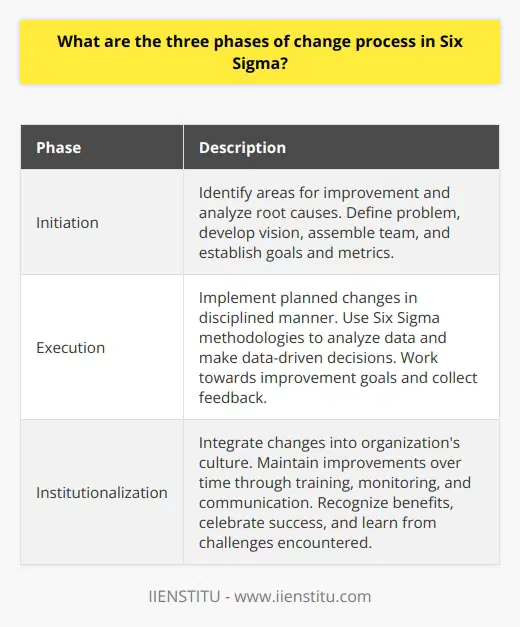
What are the four primary characteristics of the Six Sigma methodology that make it so effective?
Key Features of Six Sigma Methodology
Focusing on Customer Requirements
One crucial characteristic of the Six Sigma methodology that contributes to its effectiveness is its emphasis on understanding and meeting customer requirements. By prioritizing customer needs as the primary goal, this approach ensures that the products or services provided are aligned with customer expectations and are of the highest quality. Consequently, customer satisfaction is significantly enhanced, benefiting businesses in the long run through customer loyalty and positive word of mouth.
Elimination of Variability
Another essential feature of Six Sigma is its pursuit of reducing variation in processes, focusing on achieving consistency and predictability. By identifying and eliminating variability, the methodology ensures reduced defects and enhances product quality. Through statistical analysis, process improvements are identified and implemented, leading to standardized procedures, lower costs, and higher efficiency, ultimately resulting in a streamlined and optimally functioning organizational system.
Cross-functional Collaboration
Effective implementation of Six Sigma methodology requires the involvement and collaboration of multiple functional areas within an organization. This includes the active engagement of all levels of the workforce in the problem-solving process, fostering a culture of ongoing improvement and cooperation. By collaboratively working together to identify and address areas for improvement, cross-functional teams devise innovative and effective solutions that boost overall performance and efficiency.
Continuous Improvement
Lastly, Six Sigma promotes a culture of continuous improvement through iterative implementation of the DMAIC (Define, Measure, Analyze, Improve, and Control) framework. This systematic approach guides teams through a structured process, allowing for the identification and mitigation of performance gaps in various organizational processes. By continually analyzing existing processes and implementing necessary improvements, organizations employing Six Sigma methodology can effectively maintain a proactive and flexible approach to addressing challenges in a rapidly-changing business landscape.
In conclusion, the effectiveness of the Six Sigma methodology is enhanced by four primary characteristics: a focus on customer requirements, the elimination of variability, cross-functional collaboration, and continuous improvement. These features enable organizations to drive sustainable growth, quality enhancement, and overall efficiency in their operations, ensuring their success in a highly competitive global market.
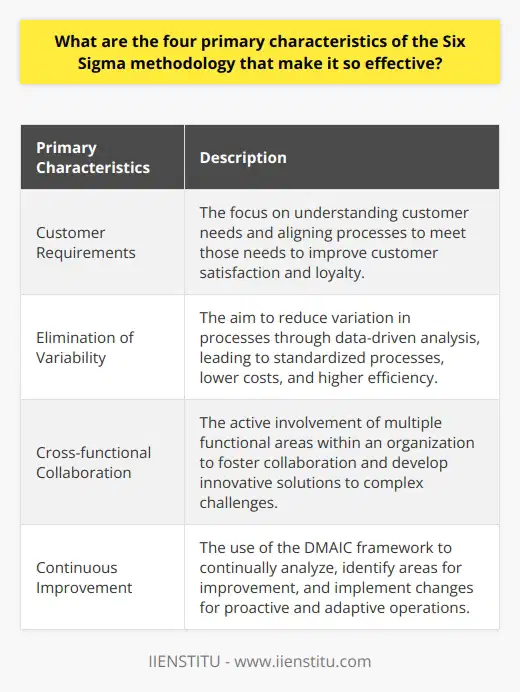
What does change management attempt to solve?
Understanding Change Management
Change management, a multidisciplinary approach, aims to help organizations identify, implement, and adapt to internal and external changes effectively. Success in today's competitive business environment is often predicated on a company's ability to innovate, grow, and react to new challenges or opportunities.
Addressing Human Factors
A primary focus of change management is resolving the resistance and obstacles often present among employees within an organization. Understanding the psychological and emotional attachment to existing processes and systems is essential in gaining their support for forthcoming changes. By providing clear communication, education, and training, change management assists employee adjustment and engagement during the transition period.
Optimizing Processes and Systems
In addition to addressing human factors, change management seeks improvements in the overall operational efficiency of the organization. By evaluating current processes and systems, change managers can identify redundancies, bottlenecks, and areas for optimization, driving increased productivity and effectiveness. A successful change management effort will align organizational objectives with strategies, ensuring that adjustments are focused on achieving business goals.
Promoting Agility and Adaptability
Change management fosters a culture of adaptability and agility, wherein organizations are better prepared to respond to external shifts in their operating environment. By encouraging a mindset of continuous improvement, change management equips organizations with the skills, knowledge, and resources necessary to anticipate changes and adjust rapidly. This adaptability extends beyond mere reaction to change – it enables businesses to proactively seek out opportunities for innovation and improvement.
Managing Risk and Uncertainty
Implementing change often entails risks and uncertainties. A comprehensive change management strategy will incorporate risk assessment and mitigation techniques that systematically address potential challenges and guide organizations’ decision-making processes. An organization that effectively employs change management principles can anticipate and manage potential threats, turning them into opportunities for growth and development.
In conclusion, change management attempts to solve several crucial issues facing organizations today: fostering employee acceptance and engagement with change, improving operational efficiency, promoting a culture of adaptability and agility, and managing risks and uncertainties associated with change. By addressing these concerns, businesses can thrive in a dynamic, ever-evolving market landscape.

What is Six Sigma in change management?
Defining Six Sigma in Change Management
Six Sigma, in the context of change management, is a systematic methodology that aims to improve an organization's processes and performance through data-driven strategies and tools. It involves identifying potential improvement areas, developing plans to address these areas, and implementing changes to enhance the organization's overall performance.
Core Principles of Six Sigma
The core principles of Six Sigma revolve around reducing variability in processes, focusing on the end customer's needs, and utilizing metrics and data analysis to drive decision-making. This approach emphasizes the importance of setting goals and tracking progress towards these goals, making it highly compatible with change management initiatives.
DMAIC Framework in Change Management
One of the most important tools used in Six Sigma and change management is the DMAIC (Define, Measure, Analyze, Improve, Control) framework. This structured approach guides organizations through each step of a change initiative, ensuring that each aspect is carefully considered and effectively implemented. The DMAIC framework fosters a data-driven approach in identifying, executing, and monitoring changes, thus making it well-suited for managing complex organizational transformations.
Benefits of Six Sigma in Change Management
The adoption of Six Sigma in change management offers numerous benefits to organizations. By employing a disciplined, data-driven approach, organizations can ensure that changes are based on a solid rationale and well-defined targets. This results in targeted improvements, which can lead to substantial enhancements in performance and customer satisfaction. Additionally, Six Sigma methodologies encourage a culture of continuous improvement within organizations, enabling them to adapt more easily to future changes in the business environment.
Challenges in Implementing Six Sigma
While Six Sigma offers significant advantages in change management, it is not without its challenges. Implementing Six Sigma requires considerable knowledge, skills, and resources, which may be difficult for some organizations to acquire. Furthermore, because Six Sigma is grounded in a data-driven approach, it relies heavily on the availability of accurate and relevant data, which may not always be easy to obtain or manage. However, when these challenges are properly addressed, the integration of Six Sigma into change management efforts can yield transformative results for organizations seeking to enhance their performance.
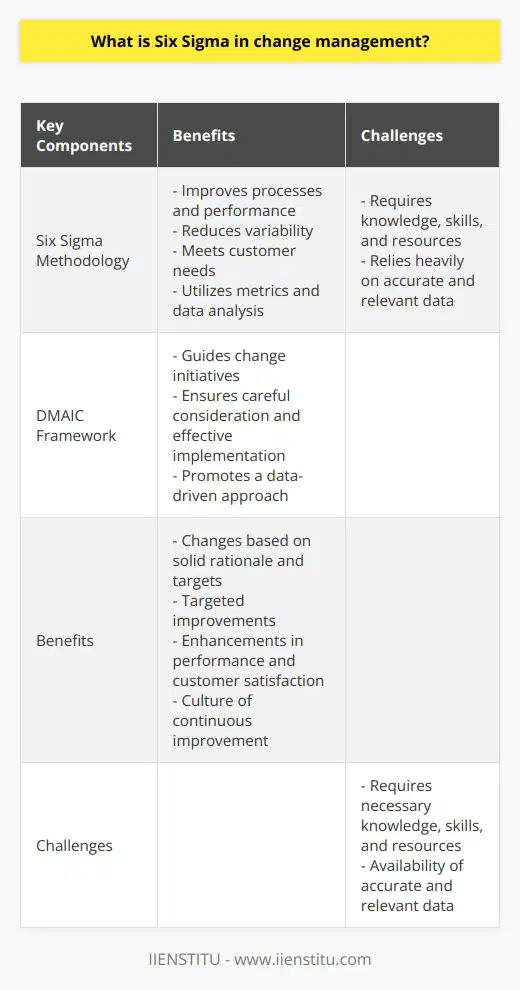
What are the six wastes of change management?
Six Wastes in Change Management
Ineffective Communication
The first waste in change management is ineffective communication. This occurs when key messages about the change initiative are not clearly conveyed to stakeholders and employees. This can lead to misunderstandings and resistance to change.
Lack of Stakeholder Engagement
The second waste is the lack of stakeholder engagement. When stakeholders are not engaged or do not perceive the need for change, they are likely to undermine the change process. It is crucial to involve stakeholders at all stages of the change initiative.
Inadequate Training and Development
The third waste is inadequate training and development. When employees lack the necessary skills, knowledge, and resources to adapt to the change, it slows down the implementation process and hinders organizational performance.
Resistance to Change
The fourth waste in change management is resistance to change. Resistance is a natural human reaction to change, and if it is not addressed properly, it can lead to wasted time, energy, and resources. This can delay or derail the change process altogether.
Poor Execution and Monitoring
The fifth waste is poor execution and monitoring. When a change initiative is poorly executed, the desired outcomes may not be achieved. Additionally, the absence of monitoring and evaluation mechanisms can prevent leaders from learning from their mistakes and adjusting their approaches.
Misaligned Incentives
The sixth waste is misaligned incentives. When employees do not see the benefits of the change or fear negative consequences, they are less likely to support the change initiative. Aligning incentives with the desired change outcomes can help to mitigate this waste.
In conclusion, the six wastes of change management include ineffective communication, lack of stakeholder engagement, inadequate training and development, resistance to change, poor execution and monitoring, and misaligned incentives. By addressing these wastes, organizations can increase the likelihood of successful change initiatives and minimize negative impacts on performance.

What is one of the seven key change concept of process model for change management?
Driving Sustainable Change
One significant key change concept of the process model for change management is driving sustainable change. This concept entails supporting lasting growth and development within an organization by implementing well-planned strategies and continual improvements.
Strategy Development
In driving sustainable change, strategy development plays a crucial role as it offers a clear direction and a roadmap for achieving the desired goals. Effective strategies involve setting realistic objectives, utilizing resources efficiently, and considering potential challenges that may arise during the change process.
Stakeholder Engagement
The involvement of stakeholders is critical for sustainable change. By engaging with employees, customers, suppliers, and other key players, organizations can create open communication channels, foster collaboration, and build commitment to the change initiative. Encouraging participation in decision-making processes and soliciting input from the stakeholders can also increase buy-in and alignment with the organization's goals.
Continuous Improvement
Sustainable change requires an ongoing commitment to evaluating and adjusting processes, systems, and practices to enhance efficiency and effectiveness. Organizations must regularly assess the success of initiatives, identifying areas for improvement and implementing relevant modifications. This continuous learning enables organizations to adapt and evolve in response to changing market conditions and stakeholder needs.
Performance Measurement
To ensure that sustainable change delivers the intended benefits, organizations must establish robust performance measurement systems. These systems should provide the necessary data to track progress, identify potential gaps, and enable decision-makers to make informed decisions. By utilizing feedback loops and analyzing performance indicators, organizations can create a culture of continuous improvement that supports lasting change.
Training and Development
Organizations must invest in the training and development of their workforce to successfully drive sustainable change. Building the necessary skills, capabilities, and competencies can empower employees to take ownership of their roles within the change initiative and contribute effectively to its success. Such efforts must be ongoing to keep pace with evolving demands and maintain a workforce that is well-equipped to manage change.
Organizational Culture
Lastly, a strong organizational culture that supports and promotes change is essential for driving sustainable change. Organizations must nurture values and beliefs that align with their change objectives, such as adaptability, resilience, and collaboration. This cultural foundation can provide employees with the motivation and understanding necessary to embrace change and work towards shared goals.
In conclusion, driving sustainable change within an organization is a multifaceted process that relies on strategy development, stakeholder engagement, continuous improvement, performance measurement, training, and development, as well as a supportive organizational culture. By focusing on these key elements, organizations can maximize the chances of successfully implementing lasting change that delivers measurable benefits and promotes sustained growth.
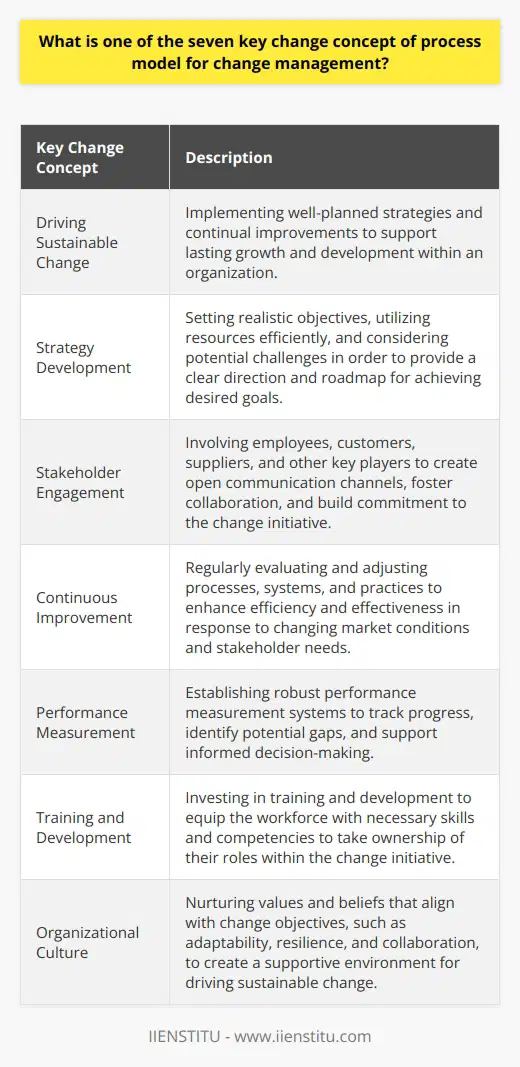
What is change management Six Sigma?
Understanding Change Management Six Sigma
Change management Six Sigma is a research-driven approach that enhances organizational efficiency. It helps businesses to modify strategies, processes, and structures to meet evolving industry standards and customer expectations.
Concept of Six Sigma in Change Management
Six Sigma features five stages, Design, Measure, Analyse, Improve and Control (DMAIC). This approach encourages corporations to define problems, measure performance, analyse solutions, improve systems, and maintain control.
Role of Six Sigma in Change Management
The success of any change agenda heavily relies on the Six Sigma methodology . It not only supports effective risk identification and mitigation, but also upkeep high-quality output while reducing errors.
Benefits of Six Sigma Approach
With this tactic, a business can save resources, time, and costs. Therefore, it positively influences customer satisfaction, employee morale, and business profitability.
The Application Process
For successful adoption, businesses should employ trained professionals, usually Green Belts or Black Belts. These experts can use change management tools such as Root Cause Analysis, Process Mapping, Value Stream Mapping, and Mistake-Proofing to implement Six Sigma.
Sustainability of Improvements
Continuous improvement is among Six Sigma's core principles. Thus, organizations can sustain the benefits by institutionalizing the approach as part of their company culture.
In conclusion, Change management Six Sigma is an analytical methodology designed to bring about resourceful modifications in business operations. It refines organisational processes, eliminates waste, reduces variability, optimizes sustainability, and lifts performance standards.
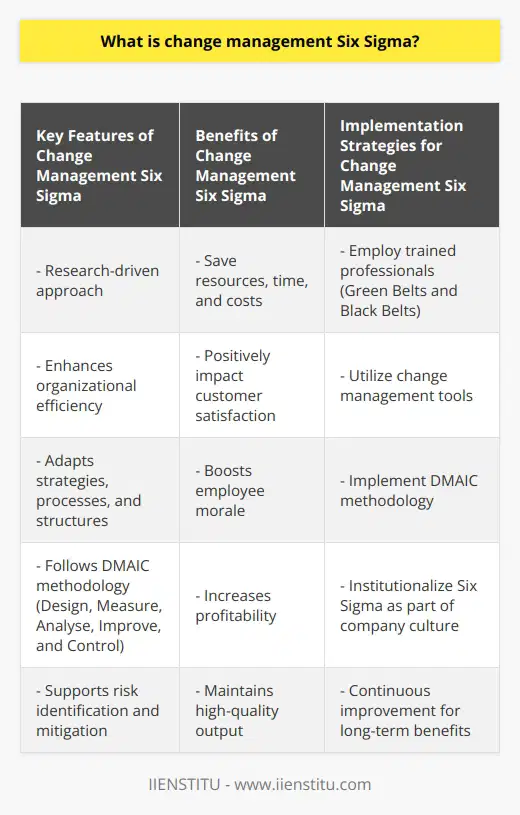
What is the six step change management model?
The Six Step Change Management Model
Understanding the Model
The Six Step Change Management Model offers a robust framework for managing change in a person, team, or organization. Developed by John Kotter, this model aids the organization in overcoming resistance to change by considering human emotion and behavior.
The First Three Steps
The first step requires establishing a sense of urgency. It necessitates illustrating the need for the change and eliciting support from others. After this, the second step involves forming a powerful coalition. Bringing together influential people, from within and outside the organization, helps in driving the change. The third step is creating a vision for change. This step focuses on developing a strategy and vision that people understand and accept.
The Final Three Steps
The fourth step concerns communicating the vision. The organization must share and communicate this new vision and strategies effectively. After this, the fifth step involves removing obstacles. This means eliminating any barriers to change, and supporting those who are driving the change. The sixth, and final step, is creating short-term wins. Organizations need to establish and celebrate short-term goals to motivate employees and generate momentum.
Conclusion
Using the Six Step Change Management Model helps organizations and individuals smoothly transition through changes. It carefully considers the human factor in change management, ensuring maximum comprehension, buyability, and effective change implementation.
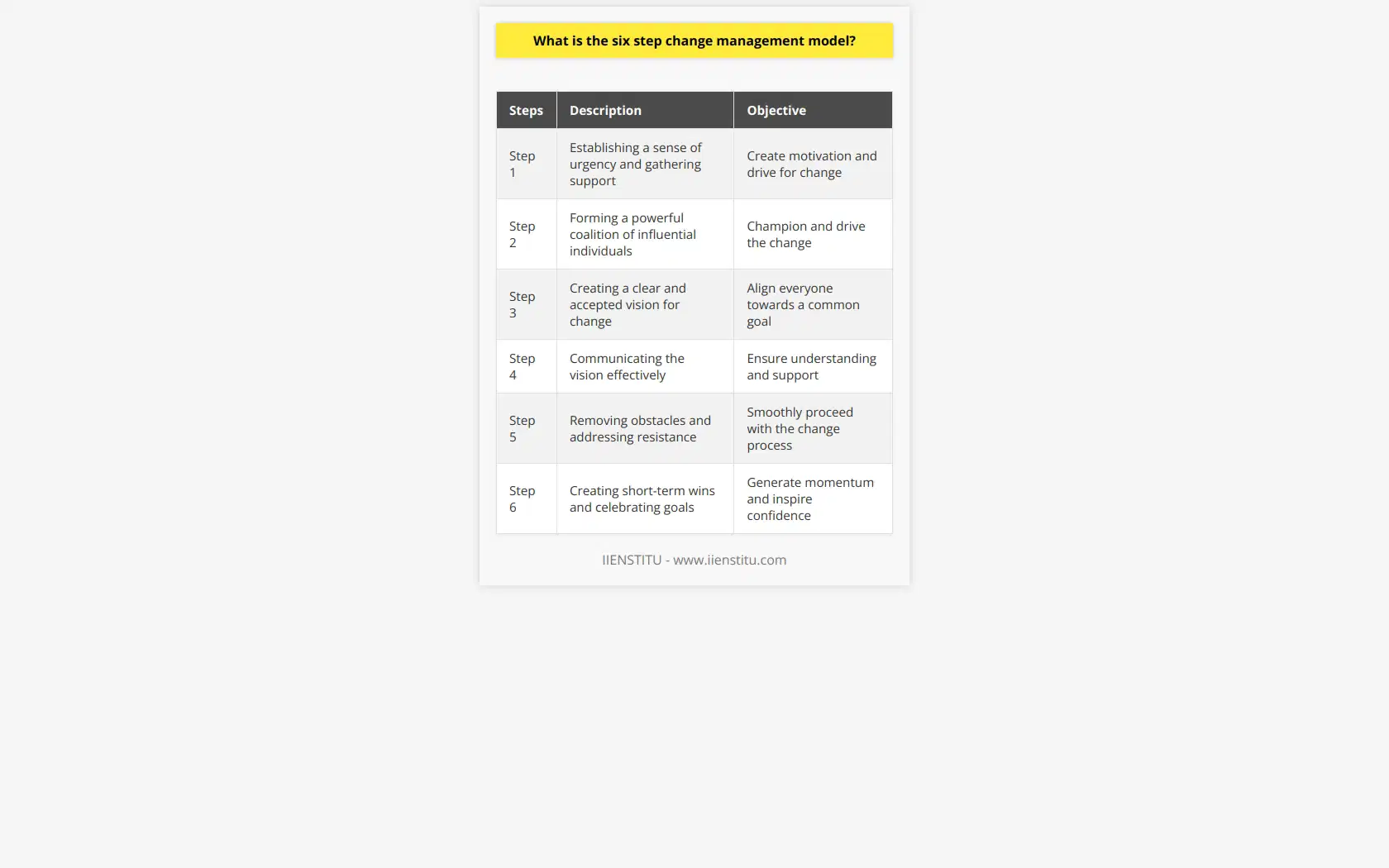
Is Six Sigma a change management model?
Understanding Six Sigma
Six Sigma does not classify as a change management model. It is a set, or system, of management techniques intended to improve business processes by greatly reducing the probability of defect.
Charactertistics of Six Sigma
Unlike typical change management models, Six Sigma centers on making consistent quality improvements until perfection is near. This approach contrasts change management, which focuses on facilitating individuals or groups to achieve desired changes.
Role of Six Sigma
Though Six Sigma does not entail a change management model, it does involve significant changes within business processes. It can call for substantial shifts in employee roles and work routines. Consequently, implementing Six Sigma often requires effective change management skills.
Nature of Change Management
Contrarily, change management is an approach focusing on the people element in change. It helps them to smoothly transit from the current way of doing things to the new ways of operation. A successful change management process keeps everyone involved and motivated towards the achievement of an organization's goals.
Interplay between Six Sigma and Change Management
Despite the differences, Six Sigma and change management can and should work hand-in-hand in a business setting. When implementing Six Sigma, change management techniques can help secure buy-in, mitigate resistance, and facilitate the overall process. Conversely, applying Six Sigma principles to change management efforts can provide a clear structure and promote greater efficiency.
In conclusion, while Six Sigma is not a change management model, there is a deep-seated relationship and synergy between the two. Both are catalysts for business improvement, each with a unique focus.
